
I’ll never forget my first big mistake. I jumped into a type of trading I didn’t understand because a friend was “killing it.” I lost money, fast. It wasn’t the market’s fault; it was mine. I hadn’t taken the time to learn the fundamental differences between the various online trading types.
See, “online trading” isn’t one single thing. It’s an umbrella term for wildly different marketplaces, each with its own rules, risks, and potential rewards. Choosing the right one for your personality and goals is the most critical decision you’ll make.
This guide is here to prevent you from making my early mistakes. We’ll dissect the four most popular online trading types— Forex, Stock trading online, Crypto trading, and Binary options. I’ll give you a clear, no-fluff breakdown of how each one works, who it’s best for, and the real risks involved. By the end, you’ll know exactly which path aligns with your goals. Let’s find your trading style.
Understanding the Landscape: A High-Level View of Online Trading Types
Before we dive into specifics, it’s crucial to understand that not all markets are created equal. They differ in three key areas:
-
Market Hours: Stocks trade during exchange hours. Forex is 24/5. Crypto is 24/7.
-
Volatility: This refers to the size and speed of price swings. Crypto is typically high volatility; major Forex pairs can be lower.
-
Complexity & Regulation: Stock markets are heavily regulated. The crypto space is known as the “wild west” for a reason.
Choosing your primary focus is about matching these characteristics with your risk tolerance, time commitment, and knowledge. Let’s break them down.
Stock Trading Online – The Foundation of Investing
When most people think of online trading types, they picture stocks. You’re buying a tiny piece of ownership (a “share”) in a public company like Apple or Tesla.
-
How it Works: You profit if the company grows and the share price increases, or through dividends (a share of the company’s profits paid to shareholders).
-
Who It’s For: Beginners, long-term investors, and those who prefer to invest in tangible businesses they can analyze.
-
Key Characteristics:
-
Regulated: Heavily supervised by bodies like the SEC (U.S. Securities and Exchange Commission).
-
Analysis-Friendly: Tons of public data (earnings reports, news) for fundamental analysis.
-
Market Hours: Typically 9:30 AM – 4:00 PM EST, Monday-Friday.
-
Actionable Tip for Beginners: Start with well-known, established companies or low-cost index ETFs (Exchange-Traded Funds) that track the entire market, like the S&P 500. This provides instant diversification.
Forex Trading – The Global Currency Marketplace
Forex (Foreign Exchange) is the world’s largest financial market, with a daily trading volume exceeding $6 trillion. It involves trading currency pairs, like EUR/USD (Euro vs. US Dollar).
-
How it Works: You speculate on whether one currency will strengthen or weaken against another. If you think the Euro will strengthen against the Dollar, you buy EUR/USD.
-
Who It’s For: Traders who can be active during major market sessions (London, New York, Asia), enjoy technical analysis, and are comfortable with high leverage.
-
Key Characteristics:
-
High Leverage: Allows controlling large positions with little capital, amplifying both gains AND losses.
-
24/5 Market: Trades 24 hours a day during the week.
-
Focus on Macroeconomics: Prices are driven by interest rates, geopolitical events, and economic data.
-
A Word of Caution: The high leverage available in Forex trading makes it exceptionally risky for beginners. It’s easy to lose more than your initial deposit.
Crypto Trading – The Digital Frontier

Crypto trading involves buying and selling digital currencies like Bitcoin (BTC) and Ethereum (ETH) on online exchanges.
-
How it Works: Similar to stock trading online, but the assets are decentralized digital tokens. Profit comes from buying low and selling high.
-
Who It’s For: Tech-savvy individuals with a high risk tolerance, who are comfortable with extreme volatility and operate outside traditional banking systems.
-
Key Characteristics:
-
High Volatility: Prices can swing 10-20% or more in a single day.
-
24/7 Market: Never closes.
-
Emerging Regulation: The regulatory environment is still developing, which adds a layer of risk.
-
Actionable Tip: If you’re new to crypto trading, never invest more than you’re willing to lose entirely. Use reputable, well-established exchanges and prioritize secure storage (like a hardware wallet) for any significant amounts.
Binary Options – The High-Risk, All-or-Nothing Bet
This is the most controversial of the online trading types. Binary options are not about owning an asset; they are a simple “yes” or “no” bet on whether an asset’s price will be above or below a certain price at a specific time (e.g., in 5 minutes).
-
How it Works: You bet a fixed amount. If you’re correct, you get a fixed payout (e.g., 70-80% profit). If you’re wrong, you lose your entire bet.
-
Who It’s For: This is not investing; it’s short-term speculation. It’s often compared to gambling.
-
Key Characteristics:
-
Fixed Risk/Reward: You know the exact potential profit and loss before you place the trade.
-
Extremely Short-Term: Trades can expire in 60 seconds or 5 minutes.
-
Heavily Scrutinized: Many financial regulators (like in the EU and the US) have banned or heavily restricted binary options for retail traders due to the high risk of fraud and investor loss.
-
Expert Insight: I strongly advise beginners to avoid Binary options. The structure is heavily skewed against the trader, and the temptation to “chase losses” can lead to rapid financial ruin.
Conclusion: Choosing Your Path Wisely
So, we’ve toured the major online trading types. Stock trading online is your foundational, long-term building block. Forex is the fast-paced, leveraged global game. Crypto trading is the volatile, digital frontier. And Binary options is the high-stakes, short-term bet that most experts warn against.
Your choice isn’t permanent, but your starting point matters. Here’s your actionable plan:
-
Be Honest About Your Risk Tolerance: If you lose sleep over a 5% drop, stocks or ETFs are your friend. If you thrive on adrenaline, crypto or forex might be more your speed.
-
Start with One: Don’t try to master all online trading types at once. Pick one that aligns with your goals and learn it inside and out. Paper trade first!
-
Prioritize Education Over Emotion: The market doesn’t care about your feelings. Build a strategy based on knowledge, not on fear or greed.
The goal isn’t to become a master of all markets overnight. It’s to find the one where your skills and personality can shine.
I want to hear from you. Which of these online trading types resonates most with you, and why? Are you a cautious investor or a thrill-seeking trader? Share your thoughts in the comments below—let’s learn from each other. If this guide clarified things for you, please pass it on to someone else who might be confused.
